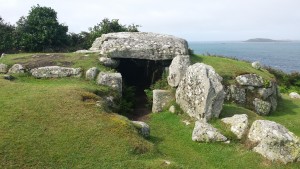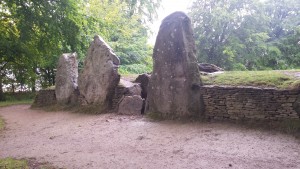I’ve had the happy experience of being on the Scilly Isles for the last couple of weeks, surrounded by ancient historical monuments as well as natural beauty, and it set me wondering about how people in the past thought about the older monuments they saw around them.

A couple of examples. On St Mary’s there is an Iron Age village, Halangy (from the early AD period). It now overlooks the stretch of water across towards Tresco, but when the island was first settled, a person standing here would be looking across a wide expanse of cultivated land towards some low hills. But up the hill from the houses, with a space carefully left between, is a much older entrance grave, Bant’s Carn, from either the Neolithic or Early Bronze Age – possibly 2 or 3000 years older. The grave overlooks both the village and the drystone walls marking out ancient field divisions.
How did the Halangy villagers regard that tomb? Was it a place of solace or spiritual protection, either in the ordinary difficulties of life or more specifically from the slow but relentless impact of rising sea levels? Or perhaps a nuisance that called for regular observances but apparently contributed nothing and took up valuable land? Or was its function lost to history by the Iron Age, and it simply stood there as an enigmatic reminder of an older time? Many such old human relics are given names suggesting they were built by giants – apparently their monumental scale made it seem impossible that they could have been built by human ancestors. But at least there would be a sense that whoever built it was living in the same place, sharing something of the same experience of life.

Another example comes from The Ridgeway. The modern national trail follows the middle portion of a very ancient trackway linking the Wash in East Anglia with the Channel coast and River Severn. It was used actively for thousands of years, and scattered along it are all kinds of monuments of the human past. The particular one I want to focus on is Waylands Smithy, a very long Neolithic burial mound beside the track which itself incorporated an older, smaller tomb within it.
Now picture yourself as a person walking the Ridgeway in the Late Bronze Age (c. 1200BC say for definiteness) – perhaps you are carrying trade goods, or going to a festival to celebrate. You camp one night close to Waylands Smithy, and wander over to look at it in the moonlight. What do you make of it? Something like 2000 years separates you from its builders, and presumably the symbolism which was clear when first constructed is obscure to you. Do you even recognise it as a burial place? And if you do, does that recognition bring comfort or anxiety? Unlike the case of Halangy village, you have no possible personal connection with the culture who erected it, and no sense that those people could be your own ancestors.
All this made me think a lot about my own writing, set in the Late Bronze Age in the Levant. Uphill from the town of Kephrath are caves used as family tombs over a number of generations. There is a very direct link between the current occupants of the town and those tombs, and so there is no mystery about them, other than the basic mystery of death. But elsewhere in the land nearby, there are older constructions, to which Kephrath and its occupants have no connection. What would they make of them?
No answers here, but a lot of provocative questions about the past!
